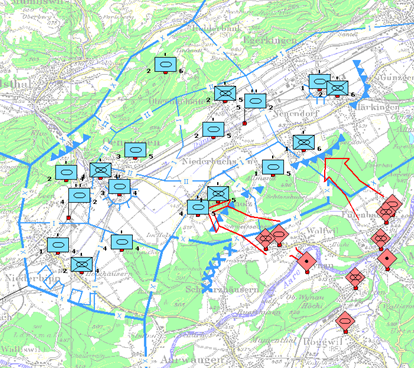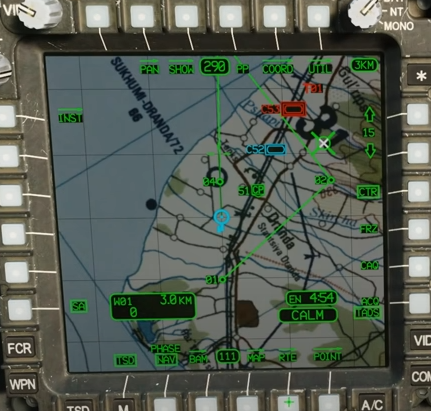-
Posts
2163 -
Joined
-
Last visited
-
Days Won
4
Content Type
Profiles
Forums
Events
Everything posted by Raptor9
-
I've seen this brought up before, and I think people have a false impression from DCS that all sensors like TGP's or electro-optical systems should have centimeter-level precision when slaving to a set of coordinates. And it's not due to 4 versus 5 digit coordinates, which is only a difference of 10 meters versus 1 meter; since such distances would be negligible when viewing a location from miles away. Even if you removed any errors in the target location storing process, a variety of factors can influence how accurately an aircraft can actually slave a sensor back to a set of coordinates. Depending on the aircraft and its individual method for determining the azimuth and elevation commands to slave to a location, the circular error of probability of the nav system, the altimeter accuracy, the heading accuracy and magnetic variation corrections embedded in the system, or even how accurately the sensor is physically mounted and calibrated to the aircraft can affect whether the target is dead center or not.
-
@Caldera, everything Leg2ion said. Regarding the indications during start. Take everything with a grain of salt since it is all still early in EA and everything is WIP. (This broken record has been brought to you by Raptor9 )
-
The engine starters are pneumatically powered using pressurized air from the APU (or a ground power unit called an AGPU, which is just a power cart with an AH-64 APU in it). Technically, the engine starters are intended to be engaged one at a time since the APU is supposed to only have enough pressurization to reliably start one engine at a time. However, I know at least one pilot that decided to test this theory and started both engines once. It apparently worked, but I don't know how quickly the engines accelerated or if the engines were closer to hot starting because of it, nor do I know what environmental conditions existed at the time this occured (which plays a big factor as well).
-
George seems to almost always slide ever so slightly to the right while hovering, like half a knot of ground speed. It's probably not the TADS. Go to an external view and check if you are truly stationary.
-

George stops lasing, Flare reload weired indication
Raptor9 replied to Rhinozherous's topic in Bugs and Problems
That's because it isn't designed to have more than 60. There are only two 30-round flare dispensers and one 30-round chaff dispenser, so the only chaff/flare mix that can be loaded is 60 flare/30 chaff. -
A game that is intended to be a certain level of accuracy to the real-life counterpart. The module isn't going to make everyone completely satisfied with how it is implemented; but on one hand you have rivet-counters that demand absolute realism (sometimes even at the price of excluding those with physical limitations), and on the other you have players that want an arcade game where everything is balanced with everything else and all planes have afterburners. Or there could just be 3 or 4 keybinds for the 3 or 4 buttons that need to be pressed. You could even bind them to 1, 2, 3, 4 on the keyboard and you would still be able to enter autorange easier than it is in real-life. You did expect this would be controversial. A lot of people may agree with you, but a lot of people will not and will argue til their face turns blue on here. But I said my piece.
-
Grab a helmet. My two cents: this is another case of asking for the DCS AH-64D to do something that it can't do in real life. Not due to limitations of player hardware, processing power, or user interface; this is altering the very functionality of the avionics. Is it annoying? Maybe. But is it realistic to how the aircraft avionics was? Yes. Also keep in mind that autorange isn't used nearly as prevalently in real life as it probably is in DCS due to the limitations of it when it comes to accuracy. If you have to "keep switching to it", I'm guessing you are often actioning the gun while your sight is HMD? In this case, the gun is intended to be used for close range suppression, so autorange isn't typically used and shouldn't matter at those close range shots anyway.
-

How to track a radio signal from ground troops with the Apache
Raptor9 replied to Toxocara's topic in DCS: AH-64D
This sort of thing is simply not how air support (CAS or otherwise) is meant to be coordinated on the battlefield, therefore such equipment isn't installed on a lot of aircraft outside of those types that take part in search and rescue operations. The entire premise is false. A lot of such technology and/or methodology can also be easily exploited by the enemy. The North Vietnamese did this a lot in the 60's/70's. -

How to track a radio signal from ground troops with the Apache
Raptor9 replied to Toxocara's topic in DCS: AH-64D
The AH-64 wasn't designed as a close air support aircraft. It was designed to be a maneuver element in the combined arms ground battle, primarily to offset the much larger ground force that the Warsaw Pact countries possessed. There is no need to get bearings to radio transmissions of friendly units in such a fight because the crews would be taking on large enemy armor formations, ideally before they even encountered friendly lines. Even if they did, they would probably just be directed by higher echelons where to go and who to contact when they arrive at that location, not sent on missions to locate units that are in contact with enemy forces. They are more like aerial artillery batteries than CAS aircraft. Other countries may use them as CAS, and outfit them with different equipment to suit that nation's doctrine, but they weren't designed for that role, despite taking on that role in recent years. Besides, if they are already talking to a ground force on the radio, they can just ask "What's your location?" -

How to track a radio signal from ground troops with the Apache
Raptor9 replied to Toxocara's topic in DCS: AH-64D
Why? -

How to track a radio signal from ground troops with the Apache
Raptor9 replied to Toxocara's topic in DCS: AH-64D
The missile warning system simply uses the ADF audio channel to relay its own audio warnings. It has nothing to do with the ADF picking up radio transmissions or giving steering signals to them. However, as I mentioned above, ground forces don't operate on those frequencies, so the answer to the question of the OP is "No, because the AH-64D has no systems that can get a bearing on the freqs that would be used." -

How to track a radio signal from ground troops with the Apache
Raptor9 replied to Toxocara's topic in DCS: AH-64D
What? -

How to track a radio signal from ground troops with the Apache
Raptor9 replied to Toxocara's topic in DCS: AH-64D
The only frequencies it can do this with is with AM freqs below 2.2 MHz, those used by NDBs and AM broadcast stations. These are well below the freqs used by ground forces, so it pretty much has no such capability. -
That's exactly what it is, except much worse and way more cringe. On the other hand, it was made in a era where you had to film the sequences with real aircraft since doing such sequences using CGI wasn't practical yet.
-
Not to be "that guy", and this isn't directed at anyone in particular, just addressing the "expectations versus reality" aspect of the laser vs optics discussion... A lot of people through no fault of their own have unrealistic impressions of how some things in real-life should be, when viewed through the lens of a DCS player. As an example, a common statement I hear to justify the usage of labels in DCS is that other aircraft or vehicles on the ground are too difficult to see unless you are extremely close. Well, that is exactly how it is in real life; in fact in some scenarios it is actually easier to spot targets in DCS compared to real life, even without labels. It can be very difficult, and that is why camouflage is still used to this day, even with all the high-tech gadgets and sensors on the modern battlefield. Likewise, there are a lot of limitations that real-world aviators have to deal with that seem inconvenient in DCS. Not everything in aviation/military that is bought by the bean-counters is the best tool to perform a task, not all aircraft are fully optimized for the missions they get tasked to perform during their lifespans, and very few things are fully equal. You could mount an identical piece of equipment like a targeting pod or radio on two different aircraft and have drastically different results in terms of performance or even the ergonomics of the cockpit interface. This comes up often when discussing various datalinks and why some aircraft aren't compatible with others. Even within Link-16-capable aircraft, there can be significant differences in what types of information can flow between different aircraft types, even though they are both on the same Link-16 network. I'm not dogging anybody, I'm just pointing out to no one in particular that what DCS simulates is the tip of iceberg to allow a reasonable immersion into combat flight sim gaming; but there is still the entire iceberg below the surface that can't be simulated due to processing/memory limitations, or for the very fact that most of it isn't even known due to security reasons. Then there's the fringe topics of discussion regarding equipment or capabilities that wikipedia claims is true, or is mentioned to be a certain way in a technical manual, and players take it as gospel without any sort of context or real-world understanding of how it actually is, and then they scream to high heaven about it not being implemented as such in DCS. If I could point out all the typos and inaccurate tidbits in from some of the real-world manuals, we would be here a hot minute.
-
Yes. It all comes down to building and maintaining situational awareness with what tools you have, including radio comms; and typically in such situations when operating in close proximity to friendly troops with IR pointers/beacons, the CPG would be wearing NVG's. You can then slave the TADS to where you are looking, and then use the TEDAC to aim the FLIR for targeting. It's something that used to be practiced often because of these very reasons. It's not as precise, and in DCS it doesn't translate well to be able to look under the NVG's at the TEDAC screen. It's not.
-
Correct, the laser LRFD shouldn't be seen under NVGs. Laser designators are not the same as IR pointers.
-
Enemy armor is not "a tank", the icon is a graphical military symbol that represents an armor unit. So if an Enemy Armor control measure is placed, with the Free Text of "1AB" as an example, that might be the enemy's 1st Armor Brigade (or however it is designated by that country's military). Control Measures by their nature are intended to be placed to assist with maintaining situational awareness of the Apache team while they conduct their mission across the battlefield. This is why CM's are not just friendly and enemy unit icons, but also include airfields, FARPs, ground lights, bridges, railheads, even military echelon markers that can be used with boundary lines. All of these graphics are intended to be able to graphically depict overlays that might be placed on a map in a TOC, but on the TSD in the cockpit so the aircrews can see where their team is on the battlefield in time and space. You're taking something like this: ...and displaying it in similar fashion on this: Having said all that, all these various points and point types (Waypoints, Hazards, Control Measures, Targets/Threats) are treated the same way in the avionics. You can make any of them your ACQ source and slave your TADS to it, you can enter their coordinates in the same fashion, you can set any of them as your nav destination, etc. The only exception is that Target/Threat points cannot be added to a route sequence. If you want to place an Enemy Armor control measure icon on a single tank, you can do that all you want. But, if you want to place any point onto the TSD, you have to select the correct point type that corresponds to the Ident code you plan on using. It makes no difference what point you use for what. You can use an Enemy Armor point to mark a taco stand in downtown Las Vegas if you want, but that doesn't change how it needs to be entered into the TSD. I'm not trying to be snarky, just trying to drive the point across with some levity.





